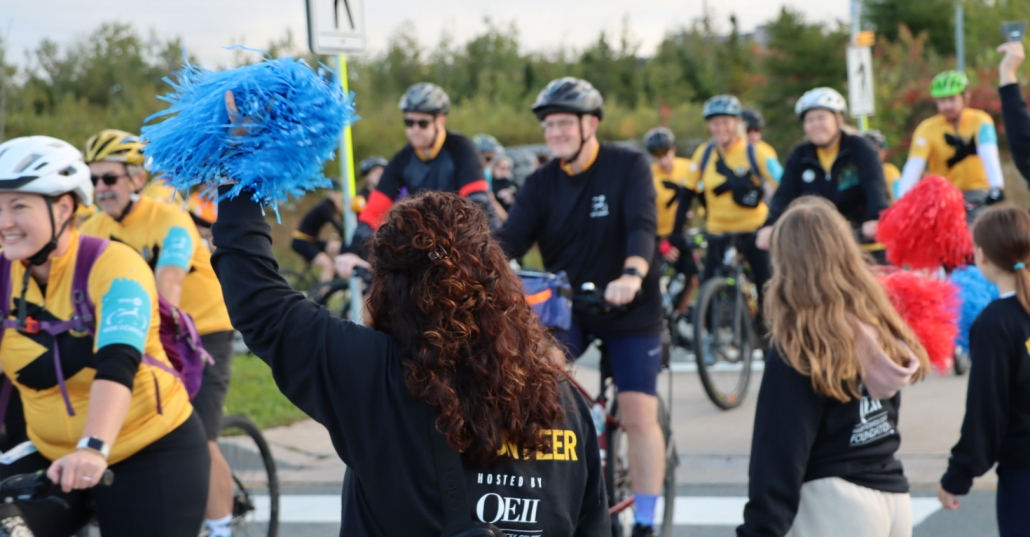Author: Kaitlynn Nordal, SaltWire/South Shore Breaker
Being told they have cancer can be the scariest words a person can hear, but the QEII [Health] Sciences Centre is working to make this time as bearable as possible.
The BMO Ride for Cancer started 10 years ago after a community member had recently lost his wife to cancer. He approached the QEII Foundation with the concept of a cycling event to transform local cancer care at the QEII.
The first year it was called Ride the Rails and was held on the rails to trails system, with 130 participants involved and raising $170,000.
“It’s very humble beginnings,” said event director Dianna MacDonald.
Fast forward to today and they are one of the top cycling fundraising events in Canada, ranking fifth in 2023.
“Going into our 2024 event, we had that extra bit of pride behind us,” said MacDonald. “It’s something we want to maintain. We are also Atlantic Canada’s largest cycling fundraising event.”
“We have had a decade of building friendships and watching the community come together for one common goal, which is ultimately to combat cancer.”
The BMO Ride for Cancer‘s goal is to combat it when someone does get diagnosed, as Nova Scotia has the highest rates in Canada, with one in three not surviving.
“BMO Ride for Cancer exists to have the treatment and the most advanced technology available for when you hear the words you have cancer,” said MacDonald.
This year, the event had over one thousand cyclists, 300 volunteers and raised $2.56-million [net].
“It’s the most we have ever raised,” said MacDonald, with $12.9 million raised over last 10 years.
BMO Ride for Cancer has two routes: 25, 50, 75 and 100km on the rails to trails portion, and 75, 100, 130 and 160km on Hwy. 3 through the South Shore of Nova Scotia.
“We get to see the most scenic views in the entire province, and I couldn’t imagine it anywhere else,” said MacDonald. “We have had opportunities to take it other places, but when you see the beauty of the South Shore, it shines through and it makes the perfect venue for this event “
MacDonald also wants to thank the communities they ride through.
“We can’t thank everyone enough. We understand we are bringing people into their communities and that can be off-putting. But everyone has embraced us (and) it’s incredible to feel embraced and come together as a province while advancing cancer care for our province,” said MacDonald.
“When we come through these communities, people share the road with our riders and they embrace us,” continued MacDonald. “They understand its only one day, so while [at times] people may be waiting to get into their driveway because of a pack of riders, we thank them.”
One of this year’s participants was Dr. Michael Carter, anatomical and molecular pathologist, and medical director of the molecular diagnostics lab at the QEII Health Sciences Centre – Victoria General site.
“It’s the only lab in the province that does molecular testing. Almost all of our work is on testing for cancer, both to diagnose and to provide prognostic information on tumours. We also provide information on what treatments are most likely to be successful,” explained Carter.
All of the money raised this year goes to liquid biopsy technology at the QEII Health Sciences Centre, which is Carter’s area.
“Historically, we have always tested a tumour specimen and that requires a biopsy, but sometimes it’s a bigger surgery that removes most or all of the tumor,” said Carter. “In the last few years, we have started testing patient’s blood. In their blood alone, we can identify tumour DNA. We can get the same information in a simple blood test that we typically required a biopsy to get. To be able to just provide a blood sample avoids the costs and risks.”
During a liquid biopsy, the lab will take a couple vials of blood and then within the part that’s not red blood cells, plasma, perform DNA sequencing on that liquid.
“We will find a lot of your normal DNA from cells that have died and released their DNA,” explained Carter. “But we will find a bit of tumour DNA shed when tumour cells died. From that tumour DNA we can get information.”
This test can help the medical team know if the patient is in remission or not.
“If we find tumour DNA, we know that that’s not the case and it can help plan the best treatment for that patient. If we don’t find any tumour DNA, then it raises the possibility that the patient was cured with their treatment,” said Carter.
The [initial] liquid biopsies being done will specifically be for lung cancer.
“That’s where we are going to start. That’s the only cancer the Canadian expert guidelines recommend using liquid biopsies in certain scenarios for. But everyone is expecting additional recommendations to come out for other tumour types.”
Carter thinks prostate cancer will be the next given the go ahead.
“There are some other cancers where liquid biopsies are becoming the preferred option over a tumour biopsy. So, I expect we will be doing some of those as well.”
Since all the funds raised from the 2023 BMO Ride for Cancer will go to his lab, Carter felt it was particularly important to participate this year beyond volunteering as usual.
“Because they were supporting our lab, a number of us felt motivated to be part of it,” said Carter. “A few people volunteered and then we had a team that were riding. It felt right to be directly involved in this amazing fundraising effort that is going to support our lab and increase the capabilities of our lab.”
Carter said it’s thanks to everyone involved that they’re able to do what they do.
“We are grateful in the lab to have this support. The QEII Foundation has been an amazing ally in our efforts here in laboratory medicine,” said Carter.




